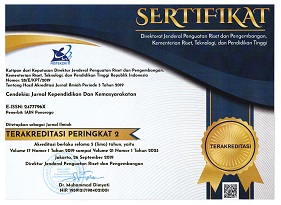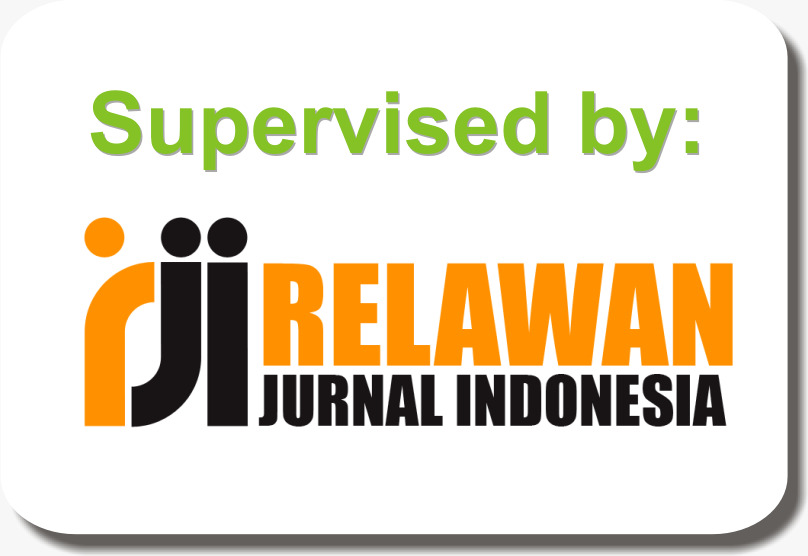Development of the Book Home 1: A Childrens`s Fiction Based on Mental Health and Montessori Paradigm (Set Within a Muslim Family Background)
DOI:
https://doi.org/10.21154/cendekia.v22i2.9872Keywords:
Montessory Thought, Children fiction, Mental HealthAbstract
This research aims to determine the intrinsic elements that will be used as a basis for developing Home 1: A children's fiction with mental health nuances and Montessori paradigm (set within a Muslim Family background); describe the development process; and the results of its development. This research is Research and Development with the Borg and Gall flow. However, the Borg and Gall path taken in this research only reached stage six, namely product development and validation testing. This product development is aimed at children aged 5 to 7 years. The use of this product is expected to continue with parental assistance. Some of the characters in this product include Lili, mama, and papa. In the validation test results, a good score was obtained, and it was considered capable of being developed. This research uses research data collection techniques in the form of observation. The result of this research is a draft of HOME 1 which consists of 10 fiction titles. As a continuation of the study, it is necessary to develop HOME 2 with a different fiction title. However, this text only mentions one storyline that represents the overall content in HOME 1.
References
Al-Saggaf, Yeslam, and Rachel Hogg. “The Effect of Children’s Phubbing on Parents’ Psychological Wellbeing: A Moderated Mediation Analysis.” Human Behavior and Emerging Technologies 1, no. 1 (2024): 1–12.
Bazhenova, Elmira Daulethanovna, Arzigul Ismailovna Shuzhebayeva, Sarbinas Mukhamedyarovna Kuntuganova, Meruert Daulethanovna Bazhenova, and Svetlana Ivanovna Murygina. “The Impact of Mobile Learning on Undergraduate Students’ Cognitive Learning Outcomes: A Meta-Analytic Review.” Interantional Journal of Engineering Pedagogy 12, no. 5 (2022): 42–53.
Bowman, Nicholas David, and C. Shawn Green. “Behavioral Addiction to Technology.” Technology, Mind, and Behavior 5, no. 4 (2024): 1–3.
Cabezas-González, Marcos, Sonia Casillas-Martín, and Ana García-ValcárcelMuñoz-Repiso. “Mediation Models Predicting the Level of Digital Competence of 12-14 Year Old Schoolchildren in the Area of Digital Problem Solving.” Journal of NewApproaches In Educational Research 11, no. 2 (2022): 168–185.
Carter, Christine Michel Carter. “The Complete Guide to Generation Alpha, the Children of Millenials.” Informasi. Forbes (blog), 2016. https://www.forbes.com/sites/christinecarter/2016/12/21/the-complete-guide-to-generation-alpha-children-of-millenials/#564a2c663623.
Çelik, Ferdi, and Meltem Huri Baturay. “Technology and Innovation in Shaping the Future of Education.” Smart Learning Environments 11, no. 54 (2024): 1–6.
Fathurahman, M. “Agama dan Ego Orang Tua (Telaag Kritis atas Spontanitas Anak dalam Pendidikan Keluarga).” Cendekia: Jurnal Kependidikan dan Kemasyarakatan 14, no. 2 (2016): 317–332.
Garrido, Mario Pena. “Mental Health, Violence, and Emotional Competencies in Adolescents.” EducacionXX1 27, no. 2 (2024): 9–16.
Gaudreau, Caroline, Yemimah A. King, Rebbeca A. Dore, Hannah Puttre, Deborah Nichols, Kathy Hirsk- Pasek, and Roberta Michnick Golinkoff. “Preschoolers Benefit Equally from Video Chat, Pseudo- Contingent Video, and Live Book Reading: Implications for Storytime During The Coronavirus Pandemic and Beyond.” Frontiers in Psychology 11 (2020): 1–17.
Herrero, Juan, Andrea Torres, Pep Vivas, and Alberto Urueña. “Smartphone Addiction and Social Support: A Three-year Longitudinal Study.” Psychosocial Intervention 28, no. 3 (2019): 111–118.
Indrayana, Marissa L., Hendro Aryanto, and Aniendya Christianna. ‘Perancangan Buku Interaktif Pembelajaran Pengembangan Karakter pada Generasi Alfa’. Undergraduate Thesis, Universitas Kristen Petra, 2018.
Kamilah, Ulufiyatul, Jauharotur Rihlah, F.K. Fitriyah, and M. Syaikhon. “Pengaruh Perilaku Kecanduan Gawai terhadap Perkembangan Bahasa Anak Usia Dini.” Child Education Journal 2, no. 2 (20202): 61–67.
Kelley, Michelle L., Gabrielle M. D’Lima, James M. Henson, and Cayla Cotten. “Substance-Abusing Mothers and Fathers’ Willingness to Allow Their Children to Receive Mental Health Treatment.” Journal of Substance Abuse Treatment 47, no. 1 (2014): 106–111.
Kosari, Farzaneh, Parviz Sabahi, and Shahrokh Makvand Hosseini. “Comparative Effects of Parent Management Training Combined With ACT and Mindful Parenting on Parent-child Relationship.” Journal of Research and Health 14, no. 2 (2024): 177–188.
Laksmi, Ni Made Sri, I Made Suardana, and Arifin Imron. “Implementasi Pembelajaran dan Penilaian Berbasis Metode Montessori.” Jurnal Pendidikan: Teori, Penelitian, dan Pengembangan 6, no. 5 (2021).
Lengfelder, Christina. “Mental Health: A Fundamental Component of Human Development.” Human Development Report, 2017. https://hdr.undp.org/content/mental-health-fundamental-component-human-development.
Lillard, Angeline S. “Preschool Children’s Development in Classic Montessori, Supplemented Montessori, and Conventional programs.” Journal of School Psychology 50, no. 3 (2012): 379–401.
Monks, F.J., A.M.P. Knoers, and S.R. Haditomo. Psikologi Perkembangan: Pengantar dalam Berbagai Bagiannya. Yogyakarta: Gajah Mada University Press, 2001.
Mulyaningsih, Neng Nenden. “Penerapan Media Pembelajaran Digital Book.” Jurnal Pendidikan Fisika V, no. 1 (2013).
OECD. PISA 2015 Results: Excellence and Equity in Education. Vol. 1. OECD, 2015. https://www.oecd.org/en/publications/education-at-a-glance-2015_eag-2015-en.html.
Puglisi, Marina L., Charles Hulme, Lorna G. Hamilton, and Margaret J. Snowling. “The Home Literacy Environment Is a Correlate, but Perhaps Not a Cause of Variations in Children’s Language and Literacy Development.” Scientific Studies of Reading 21, no. 6 (2017): 498–514.
Pulimeno, Manuela, Prisco Piscitelli, and Salvatore Colazzo. “Children’s Literature to Promote Students’ Global Development and Wellbeing.” Health Promotion Perspectives 10, no. 1 (2020): 13–23.
Putri, Weni Tria Anugrah Putri. “Dampak Penggunaan Media Sosial secara Berlebihan terhadap Regulasi Diri Anak.” Islamic Early Childhood Education 2, no. 2 (2017): 243–249.
Rahmatullah, Azam Syukur. “Pendidikan Keluarga Seimbang yang Melekat Sebagai Basis yang Mencerahkan Anak di Era Digital.” Cendekia: Jurnal Kependidikan dan Kemasyarakatan 15, no. 2 (2017): 212–224.
Rincon‑Flores, Elvira G., Leticia Castano, Sadie Lissette Guerrero Solis, Omar Olmos Lopez, Carlos Felipe Rodríguez Hernández, Laura Angélica Castillo Lara, and Laura Patricia Aldape Valdés. “Improving The Learning‑ Teaching Process Through Adaptive Learning Strategy.” Smart Learning Environments 11, no. 27 (2024): 1–27.
Rubini, Muhammad. “Hadits Tarbawi tentang Potensi Anak.” Jurnal Komunikasi dan Pendidikan Islam 4, no. 2 (2019): 25–54.
Saqr, Mohammed, and Sonsoles López‑Pernas. “Why Explainable AI May Not be Enough: Predictions and Mispredictions in Decision Making in Education.” Smart Learning Environments 11, no. 52 (2024): 1–16.
Setiyawan, Agung. “Konsep Pendidikan Anak dalam Hadis Nabi SAW (Kajian Ma’anil Hadis Sunan Ibn Majah No. 3661).” Jurnal An Nur 7, no. 1 (2015): 18–35.
Silinskas, Gintautas, Monique Senechal, Minna Torppa, and Marja- Kristiina Lerkkanen. “Home Literacy Activities and Children’s Reading Skills, Independent Reading, and Interest in Literacy Activities form Kindergarten to Grade 2.” Frontier in Psychology 11 (2020): 1–15.
Sugiyono. Metode Penelitian Pendidikan: Penelitian Kuantitatif, Kualitatif, dan R&D. Bandung: Alfabeta, 2007.
Tampubolon, D.D. Kemampuan Membaca :Teknik Membaca Efektif dan Efisien. Bandung: Angkasa, 1990.
Tim Layanan Syariah, Ditjen Bimas Islam. “Cara Wudhu Lengkap dengan Niat, Doa, dan Sunahnya.” Portal Informasi, 2023. https://kemenag.go.id/islam/cara-wudhu-lengkap-dengan-niat-doa-dan-sunahnya-tY9ZR.
Trimansyah, Bambang. Panduan Penulisan Buku Cerita Anak. Pusat Pembinaan Bahasa dan Sastra- Badan Pengembangan dan Pembinaan Bahasa- Kementerian Pendidikan dan Kebudayaan RI, 2020.
Trobert, Annet Maria. “A Life in The Service of Mental Health.” European Journal of Mental Health 10, no. 1–2 (2016): 157–160.
Tur-Porcar, Ana M., Javier Jiménez-Martínez, and Vicenta Mestre-Escrivá. “Substance Use in Early and Middle Adolescence. The Role of Academic Efficacy and Parenting.” Psychosocial Intervention 28, no. 3 (2019): 139–145.
Wawan, S., and Jauh Hari. “Begini Langkah UGM Cegah Kasus Mahasiswa Bunuh Diri Terulang.” Portal Berita dan Informasi,” 2022. https://www.detik.com/jateng/jogja/d-6342341/begini-langkah-ugm-cegah-kasus-mahasiswa-bunuh-diri-terulang.
Wilkinson, Chelsea, Michelle Oppert, and Mikaela Owen. “Investigating Academics’Attitudes Towards ChatGPT: A Qualitative Study.” Australasian Journal of Educational Technology 40, no. 4 (2024): 1–16.
World Health Organization. “Improving The Mental and Brain Health of Children and Adolescents.” Portal Informasi, 2024. https://www.who.int/activities/improving-the-mental-and-brain-health-of-children-and-adolescents.
Downloads
Published
Issue
Section
License
Copyright (c) 2024 Ahmadi, Weni Tria Anugrah Putri, Dwi Ulfa Nur Dahlia, Beta Pujangga Mukti

This work is licensed under a Creative Commons Attribution-NonCommercial 4.0 International License.
Copyright & License
Please find the rights and licenses in Cendekia: Jurnal Kependidikan dan Kemasyarakatan. By submitting the article/manuscript, the author(s) agree with this policy. No specific document sign-off is required.
1. License
The non-commercial use of the article will be governed by the Creative Commons Attribution license as currently displayed on the Creative Commons Attribution-NonCommercial 4.0 International License.
2. Author(s)' Warranties
The author warrants that the article is original, written by the stated author(s), has not been published before, contains no unlawful statements, does not infringe the rights of others, is subject to copyright that is vested exclusively in the author and free of any third party rights, and that any necessary written permissions to quote from other sources have been obtained by the author(s).
3. User/Public Rights
The spirit of Cendekia: Jurnal Kependidikan dan Kemasyarakatan is to disseminate articles published as free as possible. Under the Creative Commons license, Cendekia: Jurnal Kependidikan dan Kemasyarakatan permits users to copy, distribute, display, and perform the work for non-commercial purposes. Users will also need to attribute authors and Cendekia: Jurnal Kependidikan dan Kemasyarakatan on distributing works in the journal and other media of publications. Unless otherwise stated, the authors are public entities as soon as their articles got published.
4. Rights of Authors
Authors retain all their rights to the published works, such as (but not limited to) the following rights;
- Copyright and other proprietary rights relating to the article, such as patent rights,
- The right to use the substance of the article in own future works, including lectures and books,
- The right to reproduce the article for own purposes,
- The right to self-archive the article,
- The right to enter into separate, additional contractual arrangements for the non-exclusive distribution of the article's published version (e.g., post it to an institutional repository or publish it in a book), with an acknowledgment of its initial publication in this journal (Cendekia: Jurnal Kependidikan dan Kemasyarakatan).
5. Co-Authorship
If the article was jointly prepared by more than one author, any author submitting the manuscript warrants that he/she has been authorized by all co-authors to be agreed on this copyright and license notice (agreement) on their behalf and agrees to inform his/her co-authors of the terms of this policy. Cendekia: Jurnal Kependidikan dan Kemasyarakatan will not be held liable for anything arising due to the author(s) internal dispute. Cendekia: Jurnal Kependidikan dan Kemasyarakatan will only communicate with the corresponding author.
6. Royalties
Being an open accessed journal and disseminating articles for free under the Creative Commons license term mentioned, the author(s) are aware that Cendekia: Jurnal Kependidikan dan Kemasyarakatan entitles the author(s) to no royalties or other fees.
7. Miscellaneous
Cendekia: Jurnal Kependidikan dan Kemasyarakatan will publish the article (or have it published) in the journal if the article's editorial process is completed. The editors of Cendekia: Jurnal Kependidikan dan Kemasyarakatan may modify the paper to a style of punctuation, spelling, capitalization, referencing, and usage that deems appropriate. The author acknowledges that the article may be published so that it will be publicly accessible, and such access will be free of charge for the readers, as mentioned in point 3.

















